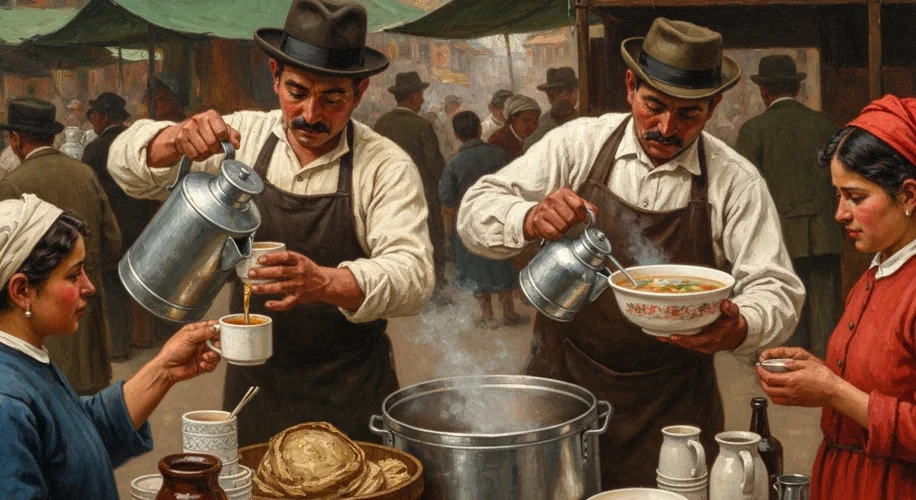Imagine a bustling city street in the late 19th century. The air is thick with the mingled scents of roasting meats, spices, and perhaps a whiff of something less savory. Amidst the cacophony of horse-drawn carts and shouting vendors, a vibrant street food culture thrives. But in an era before the ubiquity of single-use plastics and paper, how did these vendors manage to serve steaming bowls of soup or refreshing beverages without a mountain of reusable dishes, and more importantly, how did they maintain a semblance of hygiene?
This wasn’t a world of disposable conveniences. Every plate, every cup, represented an investment and a responsibility. For street food vendors, whose livelihoods depended on quick service and a steady stream of customers, the practicalities of sanitation were paramount, though perhaps viewed through a different lens than our modern understanding.
The challenge was particularly acute for vendors selling liquids. Think of the street-side lemonade stands or the vendors offering bowls of hot broth or stew. Unlike solid foods that could be served on a sturdy, washable plate, serving drinks meant dealing with cups. And these weren’t just any cups; they were often communal.

One of the most common methods for serving drinks involved reusable metal or ceramic cups. These vessels would be rinsed, sometimes with just a splash of water, between uses. While this might seem unappetizing by today’s standards, it was a far cry from the absolute absence of cleaning. Vendors understood the need to remove visible debris.
In some locales, particularly in Europe, a practice known as the “communal cup” or “public cup” was widespread. A vendor might have a limited number of cups, often made of tin or pewter, which were shared among many patrons. The vendor would typically have a bucket of water, often heated over a small brazier, and a rag. The cup would be quickly swished in the water, perhaps wiped with the rag, and then refilled. The theory, however unconvincing to us now, was that the hot water and the very act of swishing removed enough of the previous user’s germs.
Even more rudimentary methods existed. Some vendors might have used a communal sponge or cloth that was dipped into a pail of water to wipe out cups. The effectiveness of this was, naturally, highly variable and dependent on how frequently the sponge or cloth itself was cleaned – a ritual that was often neglected.
For those selling more solid fare, like pies, pastries, or even small portions of cooked meats, the method of consumption was simpler. Customers might eat directly from the vendor’s serving surface, or the food might be wrapped in paper. However, even here, hygiene was a consideration. Vendors would often use shared tongs or skewers to handle the food, and these, like the cups, would undergo a rudimentary cleaning process.
Wet foods, such as stews or porridges, presented a greater challenge. Bowls were often made of ceramic or tin. Like cups, they were likely rinsed and wiped. Some vendors might have had a more diligent approach, keeping a separate tub of clean water specifically for rinsing dishes, but this required more resources and time.
The effectiveness of these practices in preventing the spread of disease was, to put it mildly, questionable. Cities were dense, sanitation systems were often rudimentary, and the understanding of germ theory was still developing and not universally applied, especially among the working classes who relied on street food. Diseases like cholera, typhoid, and dysentery could spread rapidly in such environments.
Yet, it’s important to avoid a purely modern, judgmental perspective. These vendors were operating within the norms and technological limitations of their time. For many, street food was not a luxury but a necessity, offering affordable and accessible meals. The vendors were often part of the community they served, and their reputation for cleanliness, however basic, mattered.
Furthermore, the very nature of street food fostered a certain resilience and perhaps a higher tolerance for risk among its consumers. People were accustomed to a more visceral, less sterilized world. The sights, sounds, and even the minor hygienic compromises were part of the experience.
While we can look back with a degree of trepidation at the communal cups and quick rinses, these practices highlight a fascinating aspect of human ingenuity and adaptation. Faced with the demand for affordable, portable food in a world without disposables, street vendors found ways to serve their communities, even if those ways seem fraught with peril to our modern sensibilities. They were masters of making do, turning rudimentary tools and limited resources into a livelihood, and a vital part of the urban tapestry.

